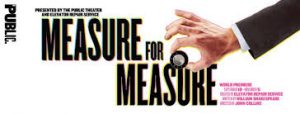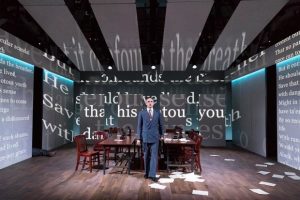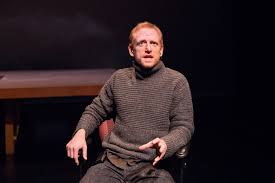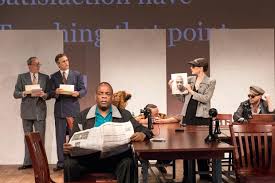 Time’s the thing. The moving thing.
Time’s the thing. The moving thing.
On the long drive back to Connecticut last night I was thinking about time in performance. The brilliant and occasionally bizarre performance of Measure for Measure I’d just seen had lasted pretty close to the canonical “two hours traffic of our stage.” I clocked the show at 2:10, with no intermission and relentless narrative drive — but those two hours contained as varied and variable an experience of theatrical time as I’ve encountered. Rushing and lingering, goofy and intense, unpredictable but also submerged in high concept: so much inside two short hours!
The most emotionally intense scene of the night, the slowest, and one of the most moving Shakespeare scenes I’ve seen in a while, was Isabella’s interview with Claudio in prison (3.1) On opposite sides of a set filled with tables, speaking to each other via old-school rotary phones, Rinne Groff’s emotionally contained Isabella faced off against Greig Sargeant’s empathetic Claudio, who’s just been instructed by the Duke that he should “Be absolute for death.” He was not buying the fatalism: his stillness and contemplative intensity oozed life. His voice demanded his sister’s (and the audience’s) attention. Why not, he seemed to say, just sleep with the prenzie Angelo in order to save my life? I’ve seen quite a few productions of this play, but I’ve not heard his lines before with such human urgency: “Ay, but to die, and go we know not where; / To lie in cold obstruction and to rot…” The Program Note from John Collins, Artistic Director of Elevator Repair Service, says that the company realized they wanted to play Measure after doing a reading of this scene. It showed.
My second and contrasting takeaway from the show was its technical innovation and varied fast-and-slow pacing, which worked in an almost perfect inversion of the emotional clarity of the prison scene. With “teleprompter software” designed by Scott Shepherd, the Wooster Group and ERS regular who also played the Duke, the company projected Shakespeare’s words on a screen on the back wall of the theater. The actors often spoke their lines with their eyes fixed in that distance. Sometimes the projected lines also appeared on stage. In a gambit that echoed Shepherd’s quite amazing performance in the Wooster Group Hamlet (2007), the company spoke its Shakespeare in visible dialogue with an onscreen and on-stage text.
I find Shepherd a fascinating and sometimes frustrating performer. He played the Duke in multiple over-broad accents, some English and some southern American, and often ran his lines so fast that even I couldn’t follow them — and I’m a Shakespearean who just finished teaching this play for the umpteenth time two weeks ago. He’s technically brilliant as an actor, but he also willfully refuses audience engagement. I’ve seen him quite a few times: back in 2007 in Wooster Group’s wonderfully bizarre Hamlet, and more recently in three different versions of his Wooster Troilus, between 2012 and 2015. In the middle performance of the three, in the group’s downtown Performing Garage space at 33 Wooster Street on a bitterly cold January night, Shepherd’s complex in-ear microphone arrangement broke mid-performance, and we all waited for 15 min with the house lights on for them to re-cue the technology. He’s clearly committed to a cyber-practice, in which human engagement with machines must be paramount. It can be alienating, but also dazzling. In this Measure it’s both.
The Duke is an ambivalent figure, and a good match for Shepherd’s own ambivalence. He’s the beneficent manipulator in contrast to his deputy Angelo’s tyrant, but he also remains shadowy, a “fantastical Duke of dark corners” (4.3) in Lucio’s apt slander. Shepherd’s performance maximized the Duke’s elusive nature. He is hard to follow and never quite available to his followers, including the audience. His exchanges with Mike Iveson’s Lucio showed a regal annoyance that was perhaps his most straightforward human reaction. His intentions toward Claudio, Escalus, and Isabella were harder to read. By the end, Shepherd’s concealing mania, tangible as the Duke rounded up his subjects for the final reversals and rewards, hinted at a depth that wasn’t quite legible as emotion but was moving nonetheless.
Speaking of divided selves, Pete Simpson’s Angelo combined comic egotism with violence and desire. He enjoyed swinging the medallion of authority around his neck in a circle, and he also gargled ostentatiously and spritzed himself with cologne before seeing Isabella, He also performed, in some moments, a looming and often silent menace. The physical breaks he performed became easier for me to understand after a quick morning google showed me that he’s a member of the Blue Man Group, and he has logged over 4,000 (!) performances for the long-running show whose home base is across the street from the Public. He wasn’t always a frightening Angelo, nor perhaps an entirely sympathetic one — but he was fun to watch. I’ve never seen this part played as a half-clown before. It perhaps unduly minimized his threat to Isabella, and perhaps also his super-hero of virtue self-conception, but it led to some interesting stage comedy.
Given a Duke so off-kilter and an Angelo so goofy, the center-around-which-we-revolved became Isabella. Rinne Groff provided the human heart inside the technological and performative hijinks. Most powerful when facing off with her brother Claudio, Groff’s Isabella humanized almost everyone she touched: the Provost, Mariana, Lucio, even Escalus. The staging emphasized one on one conversations, and in those situations Groff’s empathetic performance shone. Her separation from the underworld figures of Pompey and Mistress Overdone allowed their comic play to entertain without great consequence, because we could tell they were there mostly for fun.
I’m going again to see this production with my students on Nov 7, and in the interest of avoiding spoilers I’ll not describe the quite brilliant solution director John Collins devised for the puzzling final moment of this play, except to say that it very neatly located both Shepherd’s Duke and Groff’s Isabella in their social and human contexts.
I’m not sure how my seats are still available between now and Nov 12 — but go see it if you can!



“With “teleprompter software” designed by Scott Shepherd … the company projected Shakespeare’s words on a screen on the back wall of the theater. The actors often spoke their lines with their eyes fixed in that distance. Sometimes the projected lines also appeared on stage. In a gambit that echoed Shepherd’s quite amazing performance in the Wooster Group Hamlet (2007), the company spoke its Shakespeare in visible dialogue with an onscreen and on-stage text.”
For me, this innovation added nothing to my understanding of the play or their performance. So I’m curious, what did it add for you?
On a pretty literal level, this tactic distinguished “performance” from “text,” which has been a long-term project of Shepherd’s work with the Woosters. In a strange way, I wonder if the ERS Measure might be collapsing the difference between reading and playing, since the on-stage actors are performing the act of reading, ie, they are showing us the main way we (and our students) interact with Shakespeare’s words today. I’m not utterly convinced by it — in some ways it was distracting — but, as is often the case with these kinds of techno-innovations, it’s interesting to think about this sort of gambit as a response to or in dialogue with our fluid age of digital/print/manuscript media. I’m actually going back for a second performance with my students in a couple weeks, so maybe I’ll have more to say about this.